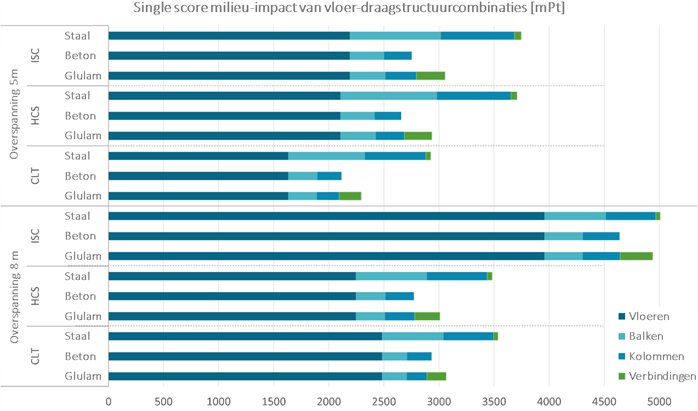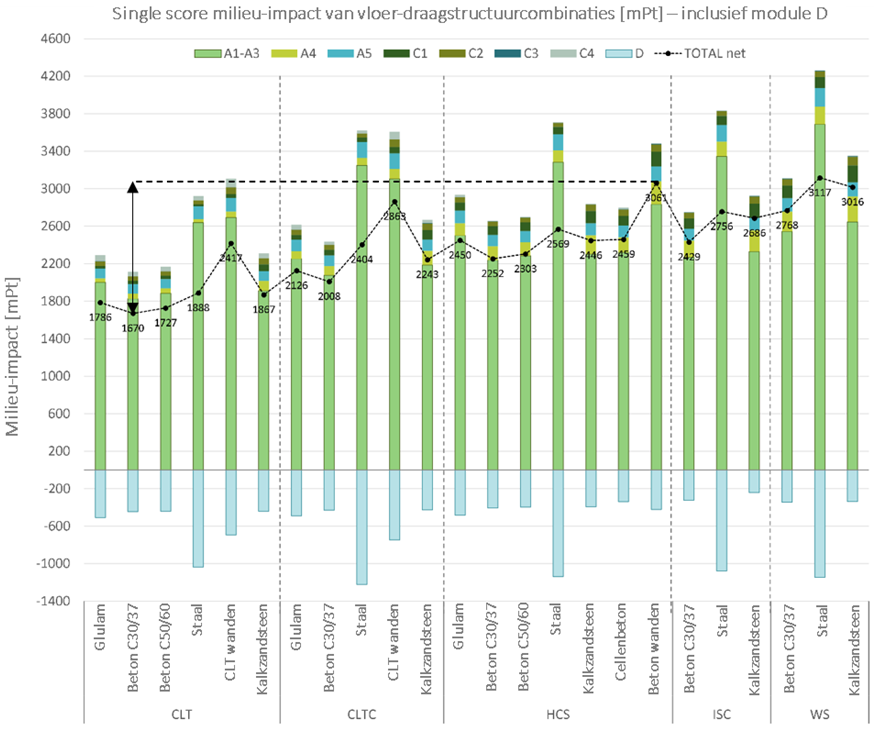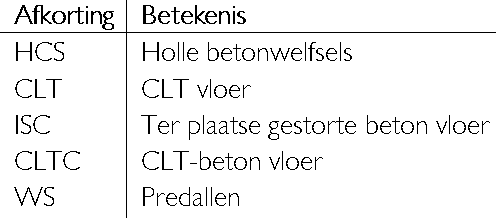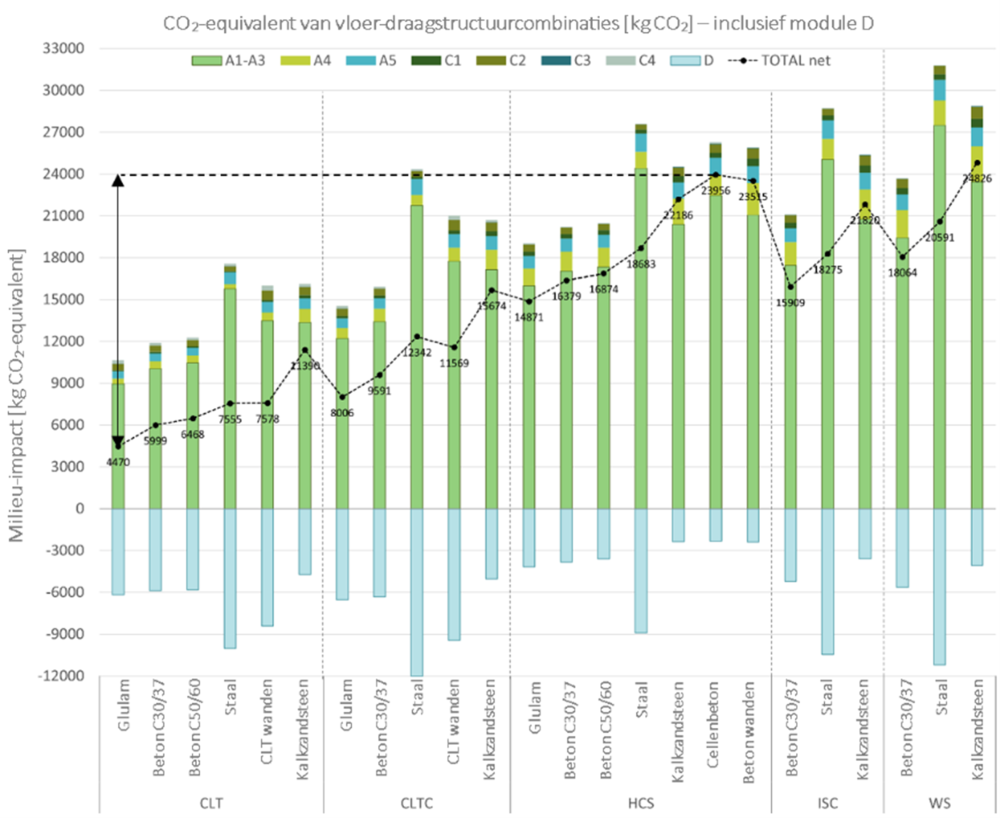ZIJN BOMEN HET NIEUWE BAKSTEEN EN BETON? - Over de milieu-impact van gebouwstructuren.
Van de recente Park & Ride Antwerp, over de appartementsblokken die rijzen langs de nieuwe dokken in Gent, tot het hoogste houten kantoorgebouw in Brussel, steeds meer hertekenen houten structuren het straatbeeld. Het ecologische karakter van dit hernieuwbare materiaal is hierbij een doorslaggevende factor in een poging om de milieu-impact van de bouwsector te reduceren. De vervuilende staal- en betonindustrie zorgen er nu immers voor dat de bouwsector verantwoordelijk is voor meer dan een derde van de energievraag en CO2-uitstoot op Europees niveau. Maar is bouwen met hout wel degelijk de geknipte oplossing om de bouwsector te vergroenen? In haar thesis ‘Vergelijkende levenscyclusanalyse van beton, staal, hout en metselwerk vloer-draagstructuurcombinaties in middelhoge gebouwen’ deed Esther Claeys hier onderzoek naar.
Van financiële naar ecologische motieven
Aangezien draagstructuren van gebouwen verantwoordelijk zijn voor het grootste materiaalverbruik, vertegenwoordigen ze een belangrijk aandeel in de milieu-impact van de bouwsector. Levenscyclusanalyse (LCA), een methode om de milieu-impact van materialen of gebouwcomponenten over hun volledige levensduur te berekenen, wordt daarom steeds vaker toegepast om de milieu-impact van deze draagstructuren in kaart te brengen. Waar in het verleden financiële overwegingen primeerden, stijgt het belang van de milieu-impact vandaag als drijfveer in de zoektocht naar een geschikt structureel ontwerp.
LCA van draagstructuren
M.b.v. LCA kan aan elk structureel ontwerp een milieuscore toegekend worden o.b.v. het materiaalverbruik, transport, energiegebruik ... en kunnen verschillende structurele oplossingen en bijhorende materialen met elkaar vergeleken worden. Hierbij worden drie levensfasen in rekening gebracht: productie- en constructiefase, gebruiksfase en eindelevensfase. Gebruikmakend van milieu-impactindicatoren wordt aan elke fase een milieu-impact toegekend.
Het CO2-equivalent is in de literatuur een van de meest-gebruikte eenheden om deze milieu-impact te kwantificeren, maar daarom niet steeds de meest accurate. Een andere, en mogelijks betere optie is de ‘single score milieu-impact’ die een gewogen gemiddelde weergeeft van verschillende indicatoren. Zo kunnen bijvoorbeeld ook land- en watergebruik of impact op de menselijke gezondheid in rekening worden gebracht. Deze bredere interpretatie van het concept ‘milieu-impact’ is van belang bij het vergelijken van verschillende basismaterialen zoals staal, beton en hout. Deze materialen beïnvloeden het milieu immers elk op hun manier.
Materiaalkeuze in draagstructuren
De typische draagstructuur van een gebouw is opgebouwd uit horizontale elementen, de vloeren, en verticale elementen, balken en kolommen of dragende muren. Voor de vloeren wordt in België overwegend beton gebruikt bv. holle betonnen welfsels of ter plaatse gestorte betonvloeren. Op basis van dit thesisonderzoek blijkt dat de single score milieu-impact van laatstgenoemde vloeren merkelijk hoger is dan deze van CLT (cross-laminated timber) of CLT-betonvloeren met een vergelijkbaar draagvermogen. Hierbij is de milieu-impact recht evenredig met het gewicht van de vloeren waardoor lichtere houten vloeren dus beter scoren. De milieu-impact van deze componenten is voor meer dan 80% toegeschreven aan het productieproces en materiaalverbruik. Dit benadrukt het belang van de juiste materiaalkeuze.

Voor de verticale structurele elementen zijn de voornaamste materialen in België gewapend beton, staal, glulam (glued laminated timber) en kalkzandsteen. Staal is steeds het meest milieubelastende materiaal. Voor de overige materialen is het verschil veel kleiner wat het moeilijk maakt om een algemene conclusie te trekken. Afhankelijk van het type invulling van het gebouw kan de voorkeur uitgaan naar een bepaald materiaal. Een open kantoorruimte met grote overspanningen verkrijgt een lagere milieu-impact bij gebruik van een gewapend beton of glulam frame. Terwijl het voor een appartementsgebouw met kleinere wooneenheden en meer scheidingswanden interessanter is om kalkzandsteenwanden te gebruiken.
Materiaalefficiëntie
Naast de materiaalkeuze is ook de materiaalefficiëntie die gepaard gaat met een structureel ontwerp een doorslaggevende factor voor de milieu-impact. Holle betonwelfsels zijn hier een goed voorbeeld. Deze vloerelementen worden voorgespannen en bevatten holle ruimtes op de locaties waar zich in een massieve plaat nodeloos materiaal bevindt, wat aanleiding geeft tot minder materiaalverbruik bij grote overspanningen. Dit resulteert in vloerelementen met een lagere milieu-impact dan houten vloeren. CLT-vloeren bijvoorbeeld, zijn hier minder geschikt aangezien het materiaalverbruik bij deze vloeren drastisch toeneemt bij grote overspanningen. Dit voorbeeld illustreert het belang van project-specifieke factoren bij de materiaalkeuze, ook vanuit ecologisch standpunt.

CO2-equivalent vs. milieu-impact
De hierboven vermelde vergelijkingen tussen verschillende materialen werden steeds gemaakt op basis van een gewogen gemiddelde milieu-impact (single score) die alle relevante milieu-impactindicatoren in rekening brengt. Maar wat met het CO2-equivalent dat vaak wordt gebruikt? Dezelfde resultaten opnieuw beoordelen op basis van hun CO2-equivalent toont dat houtcomponenten plots veel beter scoren en zelfs een negatieve milieu-impact verkrijgen in de productiefase. Bomen nemen tijdens hun groei immers CO2 op uit de atmosfeer en helpen op die manier het broeikaseffect tijdelijk te reduceren. Aangezien een CO2-equivalent enkel focust op dit aspect van de milieu-impact leidt dit tot een positiever verhaal voor hout-componenten, terwijl de milieu-impact van kalkzandsteen en staal relatief gezien toeneemt wanneer dit wordt uitgedrukt als een CO2-equivalent. Voor de laatstgenoemde materialen vertegenwoordigt het CO2-equivalent immers een veel groter deel van de totale impact dan voor hout componenten (20% t.o.v. 10%).
RIP – Recycle / reuse / recover in peace
Een manier om met een genuanceerdere blik naar milieu-impact te kijken is het toevoegen van een vierde en laatste levensfase aan de LCA, module D. Deze extra module houdt rekening met de milieu-impact van recyclage, hergebruik en energierecuperatie en is de laatste stap om een compleet beeld van de milieu-impact van een draagstructuur te verkrijgen. Waar staal een zeer groot recyclagepotentieel bezit, is voor houtcomponenten verbranding de meest voor de hand liggende eindelevensduurbehandeling. Hierbij komt de CO2 die eerder werd opgenomen door de bomen terug in de atmosfeer resulterend in een CO2-neutraliteit die het positieve karakter van hout deels tenietdoet. Anderzijds kan de warmte die hierbij vrijkomt wel gebruikt worden als energie, al is de reductie in totale impact die hiermee gepaard gaat veel kleiner dan deze corresponderend met de recyclage van staalschroot.
Een algemene trend in de resultaten is dat het verschil in milieu-impact tussen de verschillende materialen afneemt wanneer meer milieu-impactindicatoren en levenscyclusfasen in rekening worden gebracht. De impact van een stalen frame bijvoorbeeld daalt drastisch wanneer recyclage in rekening wordt gebracht, terwijl dit voor de overige materialen slechts een beperkte invloed heeft wat het netto verschil tussen beide kleiner maakt. Een vergelijkbare conclusie geldt voor het in rekening brengen van meerdere impactindicatoren.

Conclusie
Terugkerend op de vraag die initieel werd gesteld, kan worden besloten dat hout geen eenduidig antwoord vormt op de milieu-impact van de bouwsector. Op vlak van CO2-equivalent is hout ongetwijfeld de beste optie, maar dit dekt niet de volledige lading van wat een milieu-impact inhoudt. Daarom is het van belang om alle impactindicatoren en levensfasen mee te nemen in een globale milieuscore bij het beoordelen van een gebouwstructuur. Daarnaast mogen ook project-specifieke factoren niet vergeten worden. Enkel zo kan een objectieve vergelijking tussen verschillende draagstructuren tot stand komen en kan de milieu-impact materiaalkeuzes voor gebouwstructuren beïnvloeden.
Bibliografie
[1] Rijksdienst voor Ondernemend Nederland, “Milieuprestatie gebouwen - mpg.” https://www.rvo.nl/onderwerpen/ wetten-en-regels-gebouwen/milieuprestatie-gebouwen-mpg, 2017.
[2] OVAM, “Praktische gids totem voorschrijven in overheidsopdrachten,” tech. rep., OVAM, 2021.
[3] “Nbn en 15804+a2 sustainability of construction works - environmental product declarations - corerules forthe product category of construction products,” tech. rep., European committee for standardization, 2019.
[4] Z. Quist, “Product environmental footprint (pef) - a complete overview - ecochain,” NaN.
[5] C. Dossche, V. Boel, and W. D. Corte, “Use of life cycle assessments in the construction sector: Critical review,” Procedia Engineering, vol. 171, pp. 302–311, 2017.
[6] P. Chastas, T. Theodosiou, K. J. Kontoleon, and D. Bikas, “Normalising and assessing carbon emissions in the building sector: A review on the embodied CO 2 emissions of residential buildings,” Building and Environment, vol. 130, pp. 212– 226, feb 2018.
[7] P. Purnell, “Material nature versus structural nurture: The embodied carbon of fundamental structural elements,” Environmental Science & Technology, vol. 46, pp. 454–461, dec 2011.
[8] BuilderSpace, “18 benefits of concrete in construction,” 2022.
[9] C. R. Gagg, “Cement and concrete as an engineering material: An historic appraisal and case study analysis,” Engineering Failure Analysis, vol. 40, pp. 114–140, may 2014.
[10] “Making steel - arcelor mittal,” 2022.
[11] H. T. M. K. Trinh, S. Chowdhury, M. T. Nguyen, and T. Liu, “Optimising flat plate buildings based on carbon footprint using branch-and-reduce deterministic algorithm,” Journal of Cleaner Production, vol. 320, p. 128780, oct 2021.
[12] O. A. Hassan, F. Öberg, and E. Gezelius, “Cross-laminated timber flooring and concrete slab flooring: A comparative study of structural design, economic and environmental consequences,” Journal of Building Engineering, vol. 26, p. 100881, nov 2019.
[13] S. G. Maxineasa, D. N. Isopescu, I.-R. Baciu, and M. L. Lupu, “Environmental performances of a cubic modular steel structure: A solution for a sustainable development in the construction sector,” Sustainability, vol. 13, p. 12062, nov 2021.
[14] J. L. Skullestad, R. A. Bohne, and J. Lohne, “High-rise timber buildings as a climate change mitigation measure – a comparative LCA of structural system alternatives,” Energy Procedia, vol. 96, pp. 112–123, sep 2016.
[15] R. Dierikx, “Gwp of multi-storey timber buildings,” Master’s thesis, Téchnico Lisboa, 2019.
[16] K. Abahri, Sustainability of construction materials (Second edition). Woodhead Publishing, 2016.
[17] C. Kellert, “Xella sustainability report,” tech. rep., Xella, 2020. 99 Bibliography
[18] “Nbn en 15978 sustainability of construction works - assessment of environmental performance of buildings - calculation method,” tech. rep., European committee for standardization, 2012.
[19] A. Janssen, “Infofiche 64: Levenscyclusanalyse of lca,” tech. rep., WTCB, 2013.
[20] D. T. Wai Chung Lam, “Environmental profile of buildings,” tech. rep., OVAM, 2021.
[21] E. Berki, “Assessment on carbon footprint of steel frames for building structures,” Master’sthesis, Aalto University, 2020.
[22] M. C. Caruso, C. Menna, D. Asprone, A. Prota, and G. Manfredi, “Methodology for life-cycle sustainability assessment of building structures,” ACI Structural Journal, vol. 114, mar 2017.
[23] S. Sala, “Development of a weighting approach for the environmental footprint,” tech. rep., European commission, 2018.
[24] S. Kelem, “Invloed van eindelevensduurbehandeling op de milieu-impact van betonnen constructies,” Master’s thesis, Universiteit Gent, 2022.
[25] C. Knoeri, E. Sanyé-Mengual, and H.-J. Althaus, “Comparative LCA of recycled and conventional concrete for structural applications,” The International Journal of Life Cycle Assessment, vol. 18, pp. 909–918, jan 2013.
[26] Febelcem, “De belgische cementindustrie,” tech. rep., Febelcem, 2012.
[27] V. M. John, “On the sustainability of concrete,” tech. rep., Escola Politécnica, University of São Paulo, 2003.
[28] D. Wałach, P. Dybeł, J. Sagan, and M. Gicala, “Environmental performance of ordinary and new generation concrete structures—a comparative analysis,” Environmental Science and Pollution Research, vol. 26, pp. 3980–3990, dec 2018.
[29] P. Purnell and L. Black, “Embodied carbon dioxide in concrete: Variation with common mix design parameters,”Cement and Concrete Research, vol. 42, pp. 874–877, jun 2012.
[30] B. López-Mesa, Á. Pitarch, A. Tomás, and T. Gallego, “Comparison of environmental impacts of building structures with in situ cast floors and with precast concrete floors,” Building and Environment, vol. 44, pp. 699–712, apr 2009.
[31] Y. Teng, K. Li, W. Pan, and T. Ng, “Reducing building life cycle carbon emissions through prefabrication: Evidence from and gaps in empirical studies,” Building and Environment, vol. 132, pp. 125–136, mar 2018.
[32] R. Jin, J. Hong, and J. Zuo, “Environmental performance of off-site constructed facilities: A critical review,” Energy and Buildings, vol. 207, p. 109567, jan 2020.
[33] S. Eleftheriadis, P. Duffour, P. Greening, J. James, B. Stephenson, and D. Mumovic, “Investigating relationships between cost and CO2 emissions in reinforced concrete structures using a BIM-based design optimisation approach,” Energy and Buildings, vol. 166, pp. 330–346, may 2018.
[34] C. Dossche, V. Boel, and W. D. Corte, “Comparative material-based life cycle analysis of structural beam-floor systems,” Journal of Cleaner Production, vol. 194, pp. 327–341, sep 2018.
[35] J. Baetens, “Vergelijkende materiaaltechnische lca-studie van structurele vloer-balk systemen,” Master’s thesis, Universiteit Gent, 2016. 100 Bibliography
[36] Predalco, “Voordelen predallen / breedvloerplaten,” tech. rep., Predalco, 2023.
[37] S. Roh, S. Tae, S. J. Suk, and G. Ford, “Evaluating the embodied environmental impacts of major building tasks and materials of apartment buildings in korea,” Renewable and Sustainable Energy Reviews, vol. 73, pp. 135–144, jun 2017.
[38] J. L.-V. e. D. v. N. René Kraaijenbrink, “Environmental product declaration: Zwaar constructiestaal, design for reuse, overspanning tot 25m, 80% hergebruik,” tech. rep., MRPI, 2022.
[39] L. Wastiels, “End of life - module c and d,” tech. rep., Belgian building research institute.
[40] E. Broniewicz and K. Dec, “Environmental impact of demolishing a steel structure design for disassembly,” Energies, vol. 15, p. 7358, oct 2022.
[41] P. Vitale, A. Spagnuolo, C. Lubritto, and U. Arena, “Environmental performances of residential buildings with a structure in cold formed steel or reinforced concrete,” Journal of Cleaner Production, vol. 189, pp. 839–852, jul 2018.
[42] T. Pajula, “Carbon handprint guide,” tech. rep., Lappeenranta-Lahti University of Technology LUT, 2021.
[43] R. P. Johnston, T. McGrath, S. Nanukuttan, J. B. Lim, M. Soutsos, M. C. Chiang, R. Masood, and M. A. Rahman, “Sustainability of cold-formed steel portal frames in developing countries in the context of life cycle assessment and life cycle costs,” Structures, vol. 13, pp. 79–87, feb 2018.
[44] J. Hart, B. D'Amico, and F. Pomponi, “Whole-life embodied carbon in multistory buildings: Steel, concrete and timber structures,” Journal of Industrial Ecology, vol. 25, pp. 403–418, apr 2021.
[45] C. Zhu, Y. Chang, S. Su, X. Li, and Z. Zhang, “Development of q-l-EIV interactive curves for comparison of the environmental performance of composite slabs and RC slabs from the perspective of mechanical features,” Science of The Total Environment, vol. 683, pp. 508–523, sep 2019.
[46] N. Ranjbar, A. Balali, A. Valipour, A. Yunusa-Kaltungo, R. Edwards, G. Pignatta, R. Moehler, and W. Shen, “Investigating the environmental impact of reinforced-concrete and structural-steel frames on sustainability criteria in green buildings,” Journal of Building Engineering, vol. 43, p. 103184, nov 2021.
[47] A. H. S. Geoffrey Guest, Francesco Cherubini, “Global warming potential of carbon dioxide emissions from biomass stored in the anthroposphere and used for bioenergy at end of life,” Journal of industrial ecology, vol. 17, no. 1, pp. 20–30, 2012.
[48] “Nbn en 16485 round and sawn timber - environmental product declarations - product category rules for wood and wood-based products for use in construction,” tech. rep., European Committee for standardization, 2014.
[49] S. Cordier, F. Robichaud, P. Blanchet, and B. Amor, “Regional environmental life cycle consequences of material substitutions: The case of increasing wood structures for non-residential buildings,” Journal of Cleaner Production, vol. 328, p. 129671, dec 2021.
[50] F. Pierobon, M. Huang, K. Simonen, and I. Ganguly, “Environmental benefits of using hybrid CLT structure in midrise non-residential construction: An LCA based comparative case study in the u.s. pacific northwest,” Journal of Building Engineering, vol. 26, p. 100862, nov 2019. 101 Bibliography
[51] F. Asdrubali, B. Ferracuti, L. Lombardi, C. Guattari, L. Evangelisti, and G. Grazieschi, “A review of structural, thermophysical, acoustical, and environmental properties of wooden materials for building applications,” Building and Environment, vol. 114, pp. 307–332, mar 2017.
[52] S. Enso, “Cross-laminated timber (clt) - mass timber construction,” 2022.
[53] J. Iždinský, Z. Vidholdová, and L. Reinprecht, “Particleboards from recycled wood,”Forests, vol. 11, p. 1166, oct 2020.
[54] D. V. Cauteren, D. Ramon, J. Stroeckx, K. Allacker, and M. Schevenels, “Design optimization of hybrid steel/timber structures for minimal environmental impact and financial cost: A case study,” Energy and Buildings, vol. 254, p. 111600, jan 2022.
[55] H. Quesada, “Glue-laminated timber,” tech. rep., Virginia Cooperative Extension, 2022.
[56] P. Urech and T. Luthi, “Timber-concrete composite systems: Lighter weight and lower carbon,” 2020.
[57] K. M. GmbH, “Timber concrete composites,” tech. rep., KLH, 2019.
[58] A. T. Balasbaneh, A. K. B. Marsono, and S. J. Khaleghi, “Sustainability choice of different hybrid timber structure for low medium cost single-story residential building: Environmental, economic and social assessment,” Journal of Building Engineering, vol. 20, pp. 235–247, nov 2018.
[59] M. E. Puettmann, “Cradle-to-gate life cycle assessment of softwood lumber production from the northeast-north central,” tech. rep., University of Washington Seattle, 2013.
[60] O. A. Hassan, N. E. A.A., and G. Abdulahad, “A comparative study between glulam and concrete columns in view of design, economy and environment,”Case Studies in Construction Materials, vol. 16, p. e00966, jun 2022.
[61] P. E. George J. Venta, “Life cycle analysis of brick and mortar products,” tech. rep., Life cycle analysis of brick and mortar products, 1998. [62] A. Wahane, “Manfacturing process of aac block,” International journal of advance research in science and engineering, vol. 6, no. 2, pp. 4–11, 2017.
[63] Vrijders, “Onderzoek naar hoogwaardige toepassingen van cellenbetonafval,” tech. rep., OVAM, 2009.
[64] Z. Szamosi, I. Bodnár, G. L. Szepesi, M. Rosas-Casals, and L. Berényi, “Improved environmental impact in the architecture industry: LCA analysis of an alternative masonry element,” Renewable Energy, vol. 147, pp. 1718–1727, mar 2020.
[65] Verdouw, “Wat is het verschil tussen cellenbeton en kalkzandsteen?,” 2022.
[66] “Epd kalkzandsteen,” tech. rep., Stichting MRPI, 2011.
[67] H. K. Orhan Atacan, “Environmental product declaration for autoclaved aerated concrete,” tech. rep., Turkish Centre for Sustainable Production Research & Design, 2020.
[68] E. K. Yadav, “A comparitive analysys of aac blocks vs burnt bricks,” 2022. 102 Bibliography
[69] V. N. Kalkzandsteenplatform, “Onderzoek naar duurzaamheid en betaalbaarheid van kalkzandsteen woningen,” tech. rep., NIBE, 2021.
[70] N. Emami, J. Heinonen, B. Marteinsson, A. Säynäjoki, J.-M. Junnonen, J. Laine, and S. Junnila, “A life cycle assessment of two residential buildings using two different LCA database-software combinations: Recognizing uniformities and inconsistencies,” Buildings, vol. 9, p. 20, jan 2019.
[71] C. Piccardo and L. Gustavsson, “Implications of different modelling choices in primary energy and carbon emission analysis of buildings,” Energy and Buildings, vol. 247, p. 111145, sep 2021.
[72] D. F. Werner, “Backgroundreport forthe life cycle inventories of wood and wood based products for updates of ecoinvent 2.2,” tech. rep., Swiss Federals Office for the Environment, 2017.
[73] S. D. Meyer, “De milieu-impact van prefab renovatiesystemen: een waardig alternatief voor in-situ renoveren?,” Master’s thesis, Ghent University, 2020.
[74] M. Seo, “Environmental impacts of prefabricated constructino: co2 emissions comparison of precast and cast-in-place concrete,” Master’s thesis, University of Washington, 2020.
[75] J. Bergmans, “Recycling of autoclaved aerated concrete in screed and stabilized sand,” in The Fifth International Conference on Construction Materials, Flemish Institute for Technological Research, 2015.
[76] C. Leroy and L. Tikana, “Tackling recycling aspects in en15804,” in International Symposium on Life Cycle Assessment and Construction – Civil engineering and buildings, RILEM Publications SARL, 2012.
[77] M. Finkbeiner, “Life cycle inventory methodology report for steel products,” tech. rep., World Steel Association, 2017.
[78] L. Delem and L. Wastiels, “Module d inthe building life cycle: Significance based on a case study analysis,”IOP Conference Series: Earth and Environmental Science, vol. 290, p. 012042, jun 2019.
[79] “En 1991-1-1: Eurocode 1: Actions on structures,” tech. rep., European committee for standardization, 2011.
[80] Ergon, “Ergon technische gids,” tech. rep., Ergon, 2009.
[81] “Prefab systems | kolommen in gewapend beton,” 2023.
[82] “Eurocode 3 - design of steel structures,” tech. rep., European committee for standardization, 2018.
[83] “Nbn en 1996-1-1: Eurocode 6 - design of masonry structures - part 1-1: General rules for reinforced and unreinforced masonry structures,” tech. rep., European committee for standardization, 2013.
[84] Xella, “B.2 fysische en mechanische eigenschappen,” tech. rep., Xella, 2020.
[85] T. B. M. E. P. I. G. I. Eastin, “Cradle-to-gate life-cycle impact analysis of glued-laminated (glulam) timber: Environmental impacts from glulam produced in the us pacific northwest and southeast,”Forest products Journal, vol. 67, no. 5-6, 2017.















